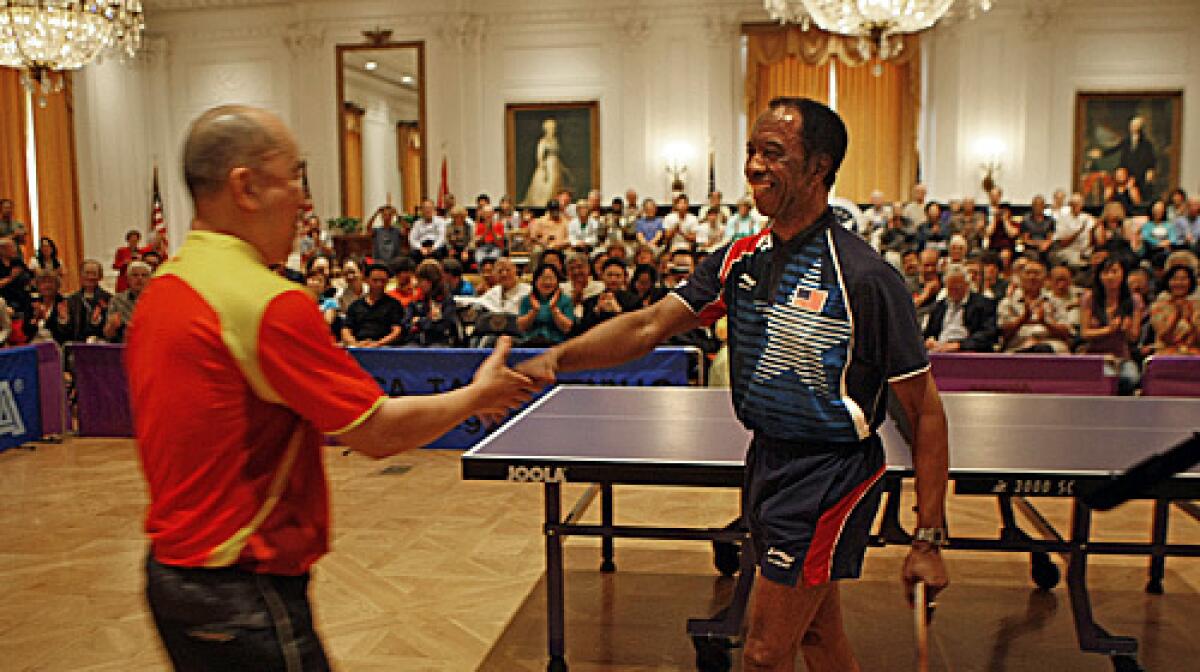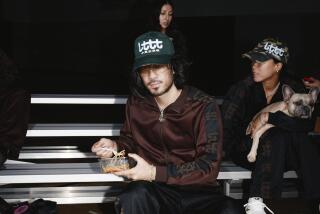Cold War-era pingpong foes meet for some back-and-forth

- Share via
While it couldn’t compete with the Lakers-Celtics rivalry, the rematch Thursday pitting professional athletes George Braithwaite and Liang Geliang had a back story that would leave even Phil Jackson envious.
They helped defrost Cold War-era tensions with a pingpong ball.
In April 1971, Braithwaite was a member of the U.S. national table tennis team that was unexpectedly invited to play a series of matches in China.
It was the first U.S. delegation to see the country since 1949, and the team’s weeklong tour set the stage for President Nixon’s groundbreaking trip to China the following year and the restoring of diplomatic relations between the nations.
Pingpong diplomacy, as it became known, did the trick.
Given that, it’s understandable that Thursday’s table tennis match between old foes Braithwaite and Geliang at the Richard Nixon Library & Birthplace in Yorba Linda was conducted without a hint of talking smack.
Still, one of them -- perhaps both -- wanted to win.
Pingpong is to China what soccer is to Brazil, and Geliang is the Pele of Chinese pingpong. The six-time world champion was at the top of his game when he played Braithwaite the first time. Braithwaite, a top U.S. pro and future member of the U.S. Table Tennis Hall of Fame, would never rise higher than 109th in the world.
Braithwaite recalls winning some games in 1971 -- improbable victories he is certain the legendary Geliang let him have.
“I have to admit, he is better,” said Braithwaite, 73, a native of Guyana who spent his career working for the United Nations. “But in sports, anything can happen on any given day. . . . It would be a real feather in my cap if I were to beat him now.”
Geliang, a national hero in China, said it didn’t matter who won.
“The friendship between athletes from both countries is what is most important,” the 58-year-old said through an interpreter.
Braithwaite was respectfully skeptical.
“I think he’s taking it quite serious. He seemed to be putting in a lot of practice this morning,” Braithwaite said the day before Thursday’s face-off. “The Chinese always project everything as friendship first. But deep down inside, they do just enough to win.”
Their match in the Nixon Library’s replica of the East Room of the White House was the highlight of a three-day commemoration of the U.S. team’s trip to China and a reciprocal visit to the United States by the Chinese team a year later -- events that captivated both nations.
Although pingpong elevated U.S.-China relations, it did next to nothing for competitive table tennis in the United States, said Tim Boggan, a member of the pingpong diplomacy team and past president of the United States Table Tennis Assn.
“When people here think of pingpong they think of something you play in the basement,” he said.
Asia’s top pros rake in millions in endorsements, salaries and tournament purses.
Braithwaite, whose nickname is “The Chief,” could never hope to make a living playing pingpong. In the mid-1970s, he was among a group of U.S. players who formed an association hoping to boost tournament prize money. They picketed the 1976 U.S. Open, at which the winners reaped a grand total of $1,500.
Pingpong diplomacy led China to ease travel restrictions, and Geliang found work as a coach and player in Europe. But the big bucks were still a generation away, he said.
He reached into a bag and pulled out a prototype of an odd-looking racket he designed. It has finger holes in the handle and a wood splint that fits into a player’s palm. It has the feel of a pair of brass knuckles with a paddle attached.
Geliang believes it could revolutionize table tennis and be a big seller. All he needs is a business partner.
“I’m not a businessman,” he said. “I am an inventor.”
Geliang is known for his all-around game. He is a steely strategist who plays defense and offense equally well. His “chop” stroke -- something U.S. players such as Braithwaite don’t often encounter -- puts so much backspin on the ball that it can be nearly impossible to return.
“George, he’s a very sophisticated player,” Boggan said of Braithwaite, his former teammate. “But George is handicapped because he plays in the States and has had few opportunities to play the world’s really good players.
“His skill factor, understandably, is not near Liang Geliang’s. But inside, he has a will of iron.”
Both men are still remarkably fit, with rock-solid calves and forearms. And it didn’t take long into their best-of-five match before it became crystal clear that this wasn’t the YMCA.
The two men traded sweeping roundhouses, delicate placement shots and huge arching slices. They battled each other up on the net and from more than 10 feet behind the table. Braithwaite grunted through power shots and Geliang darted for balls with dancer’s feet.
Braithwaite easily won the first game 11 to 4. But in the second game, Geliang chopped and chopped, feeding Braithwaite into a food processor and winning 11 to 1. The momentum had shifted Geliang’s way, and he went on to win the next two games as well.
Afterward, both men wiped sweat from their faces.
“All that chopping,” Braithwaite said, shaking his head. “He’s good.”
At least he won the first game. The scoreboard doesn’t lie. Whether Geliang let him have it will never be known. But as the Chinese champion had already pointed out, it really doesn’t matter.
More to Read
Sign up for Essential California
The most important California stories and recommendations in your inbox every morning.
You may occasionally receive promotional content from the Los Angeles Times.








